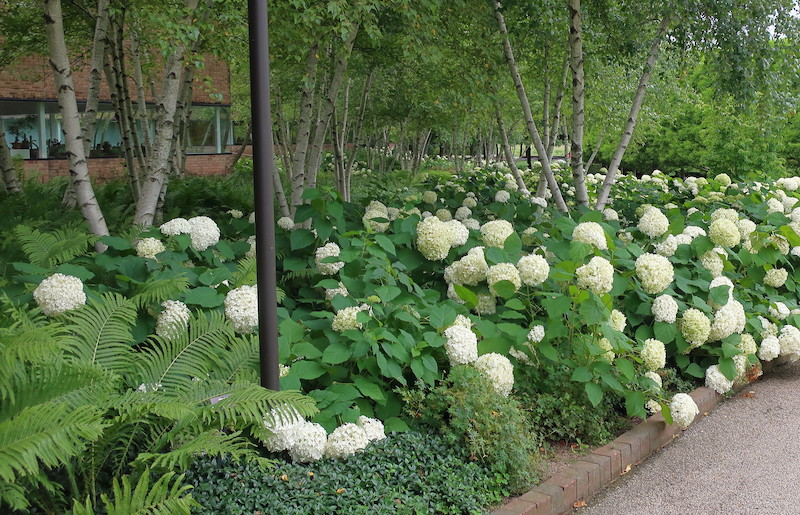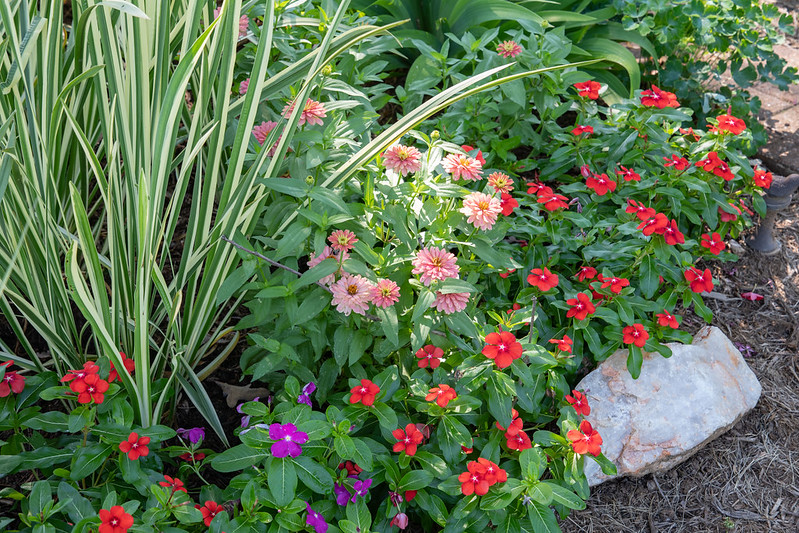Both annual and perennial vincas are valued for their ability to fill in and trail over large areas in a garden bed. The perennial vine type (hardy in USDA zones 4-11) is not only useful as a dense ground cover, but it is also commonly sold as a spiller element for hanging baskets and other mixed seasonal containers. The annual vinca flower, often called Madagascar periwinkle or Cape periwinkle, has larger flowers and blooms much more prolifically than the vine varieties. The range of flower colors is based on shades of blue, red, and white with many bicolor combinations.
Plant both types of vinca in well-draining, fertile soil that retains a good amount of moisture. Vincas accept full sun to partly shaded locations, making this plant very versatile and useful in just about any part of the garden.

Photo by cultivar413, cropped, Flickr, copyright CC BY 2.0 DEED
Shrubs To Plant With Vinca
Vinca vine is a tough and dependable ground cover in the hardiness zones 4-11 and is a low-maintenance option to plant with mixed shrub borders or at the base of foundation plants near the house. Hydrangeas, rhododendrons, azaleas, and nandina all pair well with the deep green foliage and smaller flowers of perennial vinca. Flowering annual vinca can also be used as a ground cover or a facing plant to disguise the bare lower branches of plants like roses. Plant vinca with lilacs, spirea, or weigela, which give any design a romantic feel with their soft colors and large blousy flowers from spring to the first frost in fall.
Perennials To Plant With Vinca
Both types of vinca can grow alongside perennials adapted for either part shade or full sun. The compact and upright form of annual flowering vinca works well with spreading and ground cover types of perennials, such as ajuga, creeping Jenny, and liriope. Plant the combination at the front or middle of a garden bed for best viewing. To add foliage interest, grow vinca with hostas, caladiums, alliums, and dahlias in sunny or partly shaded locations.
Perennial vinca vine works best as a ground cover with larger perennials such as bearded iris, daylilies, and Shasta daisies. Use it in any spot that could use a weed-suppressing living mulch.

Photo by Mark Levisay, unmodified, Flickr, copyright CC BY 2.0 DEED
Annuals To Plant With Vinca
Annual bedding plantings are where flowering vinca is a standout. The large flowers and glossy leaves continue to look fresh throughout the summer, no matter how hot and humid the weather gets. Use annual vinca to replace early annuals including pansies, violas, and petunias once nighttime temperatures reach 50 degrees F overnight. Add other warm-weather annuals like sweet potato vine, calibrachoa, fountain grass, and purple basil for a low-maintenance design that looks great for months. Flowering vinca can also be used as an edging plant in a kitchen garden or vegetable patch to encourage native pollinators into less ornamental parts of your yard.
Best Companion Plants For Vinca in Containers
Hanging baskets filled with both the flowering vinca and perennial vinca vine can make a dramatic statement at the entrance to a porch, front entryway, or patio seating area. Mix and match flower and foliage colors to evoke a soft and romantic feel or an edgy and modern look, depending on your mood and aesthetic.
Large planters are a great way to highlight the trailing characteristics of the vinca vine. Use decorative foliage plants like purple fountain grass, sweet potato vine, and Jacob’s coat as the base for variegated vinca to trail and spill over the planter for a long-lasting display in either full sun or part shade. Regularly fertilize the container with a diluted liquid formula that has an NPK ratio of either 2-3-1 or 2-1-1 for good foliage and flower support.

Plants Not To Grow With Vinca
Vinca vine can become a bit of a thug in some of the warmer growing zones where it remains evergreen for 12 months of the year. Do not plant it as a ground cover for delicate plants, like coral bells and saxifrage, which can be smothered by vinca’s spread over time. Although annual vinca is a great companion for roses, perennial vinca vine will likely become too aggressive in the rich, loamy soil delegated to roses.
Best Plants To Grow With Vinca
The plants you choose to grow with vinca will be most successful if they have the same growing preferences, including well-draining but moisture-retentive soil of moderate fertility. Vinca vine can become rambunctious in rich soil, but it is often the perfect solution for dry shade, where other plants may fail. For a low-maintenance planting scheme, use vinca vine to unify a simple shrub border of white hydrangeas, ostrich fern, and river Birch trees. Use flowering vinca to inject non-stop color in a mixed perennial border filled with other warm season bloomers such as variegated iris and zinnias.
 |
Author Robbin Small - Published 10-16-2023 |
